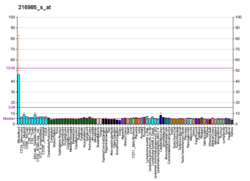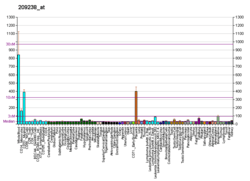Syntaxin 3
Syntaxin 3, also known as STX3, is a protein[5] which in humans is encoded by the STX3 gene.[6][7]
Function
The protein encoded by this gene is a member of the syntaxin family of cellular receptors for transport vesicles which participate in exocytosis in neutrophils.[6] STX3 has an important role in the growth of neurites and serves as a direct target for omega-6 arachidonic acid.[8] Mutations in Syntaxin 3 cause Microvillus inclusion disease.[9]
Interactions
Syntaxin 3 has been shown to interact with SNAP-25,[10][11][12] SNAP23[11][12][13][14] and SNAP29.[12]
gollark: You could say that guns are just metal pieces donated to your body too. Or, well, bullets technically.
gollark: It pipes into `less` or something. You can do `/`.
gollark: I think that's German.
gollark: The visualization thing with people's results on it.
gollark: You're actually already in the thing, but your results there are different so I guess I should update it.
References
- GRCh38: Ensembl release 89: ENSG00000166900 - Ensembl, May 2017
- GRCm38: Ensembl release 89: ENSMUSG00000041488 - Ensembl, May 2017
- "Human PubMed Reference:". National Center for Biotechnology Information, U.S. National Library of Medicine.
- "Mouse PubMed Reference:". National Center for Biotechnology Information, U.S. National Library of Medicine.
- Ibaraki K, Horikawa HP, Morita T, Mori H, Sakimura K, Mishina M, Saisu H, Abe T (June 1995). "Identification of four different forms of syntaxin 3". Biochem. Biophys. Res. Commun. 211 (3): 997–1005. doi:10.1006/bbrc.1995.1910. PMID 7598732.
- Martín-Martín B, Nabokina SM, Lazo PA, Mollinedo F (March 1999). "Co-expression of several human syntaxin genes in neutrophils and differentiating HL-60 cells: variant isoforms and detection of syntaxin 1". J. Leukoc. Biol. 65 (3): 397–406. doi:10.1002/jlb.65.3.397. hdl:10261/59829. PMID 10080545.
- "Entrez Gene: STX3 syntaxin 3".
- Darios F, Davletov B (April 2006). "Omega-3 and omega-6 fatty acids stimulate cell membrane expansion by acting on syntaxin 3". Nature. 440 (7085): 813–7. Bibcode:2006Natur.440..813D. doi:10.1038/nature04598. PMID 16598260.
- Wiegerinck CL, Janecke AR, Schneeberger K, Vogel GF, van Haaften-Visser DY, Escher JC, Adam R, Thöni CE, Pfaller K, Jordan AJ, Weis CA, Nijman IJ, Monroe GR, van Hasselt PM, Cutz E, Klumperman J, Clevers H, Nieuwenhuis EE, Houwen RH, van Haaften G, Hess MW, Huber LA, Stapelbroek JM, Müller T, Middendorp S (2014). "Loss of syntaxin 3 causes variant microvillus inclusion disease". Gastroenterology. 147 (1): 65–68.e10. doi:10.1053/j.gastro.2014.04.002. PMID 24726755.
- Hata Y, Südhof TC (Jun 1995). "A novel ubiquitous form of Munc-18 interacts with multiple syntaxins. Use of the yeast two-hybrid system to study interactions between proteins involved in membrane traffic". J. Biol. Chem. 270 (22): 13022–8. doi:10.1074/jbc.270.22.13022. PMID 7768895.
- Ravichandran V, Chawla A, Roche PA (Jun 1996). "Identification of a novel syntaxin- and synaptobrevin/VAMP-binding protein, SNAP-23, expressed in non-neuronal tissues". J. Biol. Chem. 271 (23): 13300–3. doi:10.1074/jbc.271.23.13300. PMID 8663154.
- Steegmaier M, Yang B, Yoo JS, Huang B, Shen M, Yu S, Luo Y, Scheller RH (Dec 1998). "Three novel proteins of the syntaxin/SNAP-25 family". J. Biol. Chem. 273 (51): 34171–9. doi:10.1074/jbc.273.51.34171. PMID 9852078.
- Imai A, Nashida T, Yoshie S, Shimomura H (Aug 2003). "Intracellular localisation of SNARE proteins in rat parotid acinar cells: SNARE complexes on the apical plasma membrane". Arch. Oral Biol. 48 (8): 597–604. doi:10.1016/S0003-9969(03)00116-X. PMID 12828989.
- Araki S, Tamori Y, Kawanishi M, Shinoda H, Masugi J, Mori H, Niki T, Okazawa H, Kubota T, Kasuga M (May 1997). "Inhibition of the binding of SNAP-23 to syntaxin 4 by Munc18c". Biochem. Biophys. Res. Commun. 234 (1): 257–62. doi:10.1006/bbrc.1997.6560. PMID 9168999.
Further reading
- Ibaraki K, Horikawa HP, Morita T, Mori H, Sakimura K, Mishina M, Saisu H, Abe T (1995). "Identification of four different forms of syntaxin 3". Biochem. Biophys. Res. Commun. 211 (3): 997–1005. doi:10.1006/bbrc.1995.1910. PMID 7598732.
- Hata Y, Südhof TC (1995). "A novel ubiquitous form of Munc-18 interacts with multiple syntaxins. Use of the yeast two-hybrid system to study interactions between proteins involved in membrane traffic". J. Biol. Chem. 270 (22): 13022–8. doi:10.1074/jbc.270.22.13022. PMID 7768895.
- Li C, Ullrich B, Zhang JZ, Anderson RG, Brose N, Südhof TC (1995). "Ca(2+)-dependent and -independent activities of neural and non-neural synaptotagmins". Nature. 375 (6532): 594–9. Bibcode:1995Natur.375..594L. doi:10.1038/375594a0. PMID 7791877.
- Morgans CW, Brandstätter JH, Kellerman J, Betz H, Wässle H (1996). "A SNARE complex containing syntaxin 3 is present in ribbon synapses of the retina". J. Neurosci. 16 (21): 6713–21. doi:10.1523/JNEUROSCI.16-21-06713.1996. PMID 8824312.
- Tellam JT, Macaulay SL, McIntosh S, Hewish DR, Ward CW, James DE (1997). "Characterization of Munc-18c and syntaxin-4 in 3T3-L1 adipocytes. Putative role in insulin-dependent movement of GLUT-4". J. Biol. Chem. 272 (10): 6179–86. doi:10.1074/jbc.272.10.6179. PMID 9045631.
- Delgrossi MH, Breuza L, Mirre C, Chavrier P, Le Bivic A (1997). "Human syntaxin 3 is localized apically in human intestinal cells". J. Cell Sci. 110 (18): 2207–14. PMID 9378770.
- Galli T, Zahraoui A, Vaidyanathan VV, Raposo G, Tian JM, Karin M, Niemann H, Louvard D (1998). "A novel tetanus neurotoxin-insensitive vesicle-associated membrane protein in SNARE complexes of the apical plasma membrane of epithelial cells". Mol. Biol. Cell. 9 (6): 1437–48. doi:10.1091/mbc.9.6.1437. PMC 25366. PMID 9614185.
- Riento K, Galli T, Jansson S, Ehnholm C, Lehtonen E, Olkkonen VM (1998). "Interaction of Munc-18-2 with syntaxin 3 controls the association of apical SNAREs in epithelial cells". J. Cell Sci. 111 (17): 2681–8. PMID 9701566.
- Steegmaier M, Yang B, Yoo JS, Huang B, Shen M, Yu S, Luo Y, Scheller RH (1998). "Three novel proteins of the syntaxin/SNAP-25 family". J. Biol. Chem. 273 (51): 34171–9. doi:10.1074/jbc.273.51.34171. PMID 9852078.
- Martín-Martín B, Nabokina SM, Lazo PA, Mollinedo F (1999). "Co-expression of several human syntaxin genes in neutrophils and differentiating HL-60 cells: variant isoforms and detection of syntaxin 1". J. Leukoc. Biol. 65 (3): 397–406. doi:10.1002/jlb.65.3.397. hdl:10261/59829. PMID 10080545.
- Fasshauer D, Antonin W, Margittai M, Pabst S, Jahn R (1999). "Mixed and non-cognate SNARE complexes. Characterization of assembly and biophysical properties" (PDF). J. Biol. Chem. 274 (22): 15440–6. doi:10.1074/jbc.274.22.15440. PMID 10336434.
- Thomas DM, Ferguson GD, Herschman HR, Elferink LA (1999). "Functional and biochemical analysis of the C2 domains of synaptotagmin IV". Mol. Biol. Cell. 10 (7): 2285–95. doi:10.1091/mbc.10.7.2285. PMC 25443. PMID 10397765.
- Riento K, Kauppi M, Keranen S, Olkkonen VM (2000). "Munc18-2, a functional partner of syntaxin 3, controls apical membrane trafficking in epithelial cells". J. Biol. Chem. 275 (18): 13476–83. doi:10.1074/jbc.275.18.13476. PMID 10788461.
- Kauppi M, Wohlfahrt G, Olkkonen VM (2002). "Analysis of the Munc18b-syntaxin binding interface. Use of a mutant Munc18b to dissect the functions of syntaxins 2 and 3". J. Biol. Chem. 277 (46): 43973–9. doi:10.1074/jbc.M208315200. PMID 12198139.
- Imai A, Nashida T, Yoshie S, Shimomura H (2003). "Intracellular localisation of SNARE proteins in rat parotid acinar cells: SNARE complexes on the apical plasma membrane". Arch. Oral Biol. 48 (8): 597–604. doi:10.1016/S0003-9969(03)00116-X. PMID 12828989.
- Bandyopadhyay BC, Swaim WD, Liu X, Redman RS, Patterson RL, Ambudkar IS (2005). "Apical localization of a functional TRPC3/TRPC6-Ca2+-signaling complex in polarized epithelial cells. Role in apical Ca2+ influx". J. Biol. Chem. 280 (13): 12908–16. doi:10.1074/jbc.M410013200. PMID 15623527.
- Rual JF, Venkatesan K, Hao T, Hirozane-Kishikawa T, Dricot A, Li N, Berriz GF, Gibbons FD, Dreze M, Ayivi-Guedehoussou N, Klitgord N, Simon C, Boxem M, Milstein S, Rosenberg J, Goldberg DS, Zhang LV, Wong SL, Franklin G, Li S, Albala JS, Lim J, Fraughton C, Llamosas E, Cevik S, Bex C, Lamesch P, Sikorski RS, Vandenhaute J, Zoghbi HY, Smolyar A, Bosak S, Sequerra R, Doucette-Stamm L, Cusick ME, Hill DE, Roth FP, Vidal M (2005). "Towards a proteome-scale map of the human protein-protein interaction network". Nature. 437 (7062): 1173–8. Bibcode:2005Natur.437.1173R. doi:10.1038/nature04209. PMID 16189514.
- Low SH, Vasanji A, Nanduri J, He M, Sharma N, Koo M, Drazba J, Weimbs T (2006). "Syntaxins 3 and 4 are concentrated in separate clusters on the plasma membrane before the establishment of cell polarity". Mol. Biol. Cell. 17 (2): 977–89. doi:10.1091/mbc.E05-05-0462. PMC 1356605. PMID 16339081.
This article is issued from Wikipedia. The text is licensed under Creative Commons - Attribution - Sharealike. Additional terms may apply for the media files.





